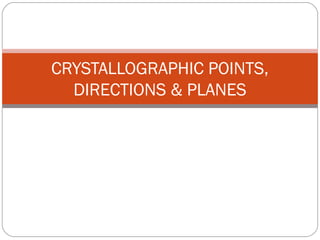
Crystallographic points, directions & planes
- 1. CRYSTALLOGRAPHIC POINTS, DIRECTIONS & PLANES
- 2. For more help contact me Muhammad Umair Bukhari Engr.umair.bukhari@gmail.com www.bzuiam.webs.com 03136050151
- 3. CRYSTALLOGRAPHIC POINTS, DIRECTIONS & PLANES In crystalline materials, often necessary to specify points, directions and planes within unit cell and in crystal lattice Three numbers (or indices) used to designate points, directions (lines) or planes, based on basic geometric notions The three indices are determined by placing the origin at one of the corners of the unit cell, and the coordinate axes along the unit cell edges
- 4. POINT COORDINATES Any point within a unit cell specified as fractional multiples of the unit cell edge lengths Position P specified as q r s; convention: coordinates not separated by commas or punctuation marks
- 5. EXAMPLE: POINT COORDINATES Locate the point (1/4 1 ½) • Specify point coordinates for all atom positions for a BCC unit cell – Answer: 0 0 0, 1 0 0, 1 1 0, 0 1 0, ½ ½ ½, 0 0 1, 1 0 1, 1 1 1, 0 1 1
- 6. CRYSTALLOGRAPHIC DIRECTIONS Defined as line between two points: a vector Steps for finding the 3 indices denoting a direction Determine the point positions of a beginning point (X1 Y1 Z1) and a ending point (X2 Y2 Z2) for direction, in terms of unit cell edges Calculate difference between ending and starting point Multiply the differences by a common constant to convert them to the smallest possible integers u, v, w The three indices are not separated by commas and are enclosed in square brackets: [uvw] If any of the indices is negative, a bar is placed in top of that index
- 8. EXAMPLES: DIRECTIONS Draw a [1,-1,0] direction within a cubic unit cell • Determine the indices for this direction – Answer: [120]
- 9. CRYSTALLOGRAPHIC PLANES Crystallographic planes specified by 3 Miller indices as (hkl) Procedure for determining h,k and l: Z If plane passes through origin, translate plane or choose new origin Determine intercepts of planes on each of the axes in terms of unit cell edge lengths (lattice parameters). Note: if plane has no intercept to an axis (i.e., it is 1 /2 parallel to that axis), intercept is infinity (½ ¼ ½) Determine reciprocal of the three intercepts (2 4 2) 1 /4 Y If necessary, multiply these three numbers by a common 1 /2 factor which converts all the reciprocals to small integers (1 2 1) (1 2 1 ) X The three indices are not separated by commas and are enclosed in curved brackets: (hkl) (121) If any of the indices is negative, a bar is placed in top of that index
- 10. THREE IMPORTANT CRYSTAL PLANES ( 1 0 0) (1 1 0 ) (1 1 1 )
- 11. THREE IMPORTANT CRYSTAL PLANES Parallel planes are equivalent
- 12. EXAMPLE: CRYSTAL PLANES Construct a (0,-1,1) plane
- 13. FCC & BCC CRYSTAL PLANES Consider (110) plane • Atomic packing different in the two cases • Family of planes: all planes that are crystallographically equivalent—that is having the same atomic packing, indicated as {hkl} – For example, {100} includes (100), (010), (001) planes – {110} includes (110), (101), (011), etc.
